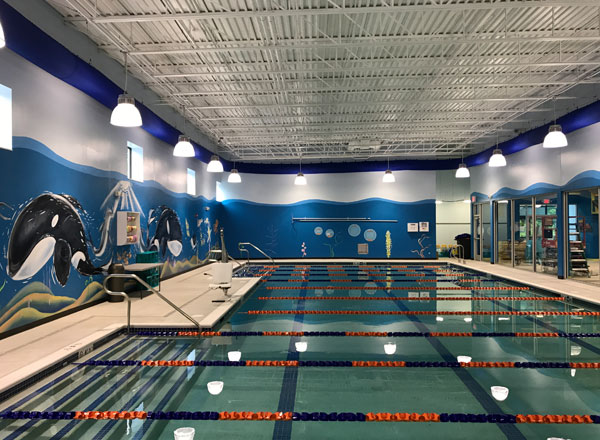As community pools across Europe are being upgraded, the preferred new air dispersion technology is fabric based. Fabric ducting is corrosion-free and offers unrivalled airflow precision, which creates a healthier more comfortable indoor environment.
Throughout the 70's and 80's many European governments invested in community pool facilities. These have aged to a point where refurbishment is inevitable and the ventilation solutions must be changed.
Over the years there has been a number of accidents involving corroded ductwork where pieces of ducts or diffusers have fallen from the ceiling. Luckily very few of these cases have led to injuries; it has, however, led to stricter guidelines for ventilation in highly corrosive environments such as pools and spas, which consequently has led architects and engineers to search for alternative solutions to replace the conventional spiral ducts.
Fabric-based air dispersion solutions is becoming the no. 1 choice in pool and spa ventilation because of what the technology offers in terms of safety, hygiene and healthy air quality. The technology is inherently corrosion-free and with complete freedom in design, it is also an opportunity for the architects to playfully integrate the ventilation solution into the building.
Creating the ideal air dispersion solution for a pool or spa area requires strict attention to airflows regardless of the technology used. Occupant health is a key factor and so is the health of the building itself. The chlorine vapors from the pool are heavier than air, thus settle as a gassy layer just above the pool surface. Feathering down this hazardous gas is of utmost importance; however, if the air velocity is too high, it accelerates the evaporation from the pool water.
Fabric-based duct technology offers the highest level of precision in air dispersion design. By combining different flow models, the engineers can create the ideal airflow for each section of the pool area. Swimmers require a supply of fresh air at low velocity to counter the evaporating gasses from the water surface. Spectators require a high air change without drafts to be comfortable in the tropical conditions of the locale. And the building structure and various fixtures require airflows that sweep condensation off their surfaces to prevent dripping, mold growth and corrosion.
The fabric ducts are corrosion-free and condensation-free by nature. They are tailored from polyester textiles, which are not vulnerable in harsh and corrosive environments. Due to the permeability of the fabrics used in such applications, an air blanket is generated around the length and circumference of the duct, efficiently preventing condensation and hindering dust and dirt particles from settling onto the ductwork. The latter is great for the hygiene, as conventional metal ducting is an infamous breeding ground for microbial activity. Should dirt somehow get on the outside of the ducts, it is easy to slide the ducting off the suspension, wash it in a machine and hang it up again without having to drain the pool or even close the facility.
Recently, engineers dismantled a 15 year old metal duct in a pool in Spain and were chocked to see the amount of filth hiding inside the ducting. After 15 years in the hot, humid pool environment the duct itself was visibly highly corroded, as were the diffusers, representing a safety hazard to the users of the community pool. The engineering team were surprised to learn how bad a state the old metal duct had really been in, and were unanimous in the decision to use a better technology for the replacement solution.
The old oxidized duct was replaced by state-of-the-art fabric-based solution tailored in anti-microbial FabricAir® Combi 80 with a selection of flow models specifically suited to the location. Technical Manager, Toni Valle, explains the decision:
"FabricAir proposed an adapted design with improvements in the air dispersion that allowed us to avoid condensation in areas where it had previously occurred. An optimal hygienic solution in anti-bacterial textile was proposed in view of the state of the old sheet metal duct. The design allowed us to adapt it to the outlets of the previous installation. Aesthetically it integrates very well with the wooden cover, which was somewhat complex with the sheet metal. In addition, FabricAir provided accessories for the installation meeting the tight dates required to make the replacement."
Using the airflow to sweep surfaces prevents the formation of condensation. This is used to increase the life expectancy of e.g. window frames as these may rot if allowed to stay damp, which in turn spurs the growth of health hazardous fungi like black mold that thrives in hot and humid environments. The technique is also typically used to sweep condensation from surfaces of light fixtures, sprinkler systems, cable trays, HiFi equipment and other items that is mounted using metal brackets and fitting to diminish the risk of corrosion in these elements and increase the life expectancy of the equipment despite the tropical conditions of the pool area.
In Calgary, Canada, the outdoor temperature can be freezing. The difference between the indoor and outdoor temperature caused the air to condensate on the ceiling of the Talisman Center, creating unsafe conditions for the athletes using the facility. The engineers used FabricAir dispersion technology to sweep the ceiling surface, thus removing the condensation problem, while also creating a healthier and more pleasant indoor environment for the center’s users.
See the video from the Talisman Center project here: youtu.be/ByNekchYbwU.
Once architects are given the freedom to use the air dispersion as a design element, it yields playful and well-integrated designs. The Gold Fish Swim Schools are using the technology as an incorporated design element in all their facilities, matching the duct colour to the overall colour scheme of the facilities.
In Australia, the architects behind the Elizabeth Aquadome playfully matched the air dispersion system to the water slides combining color and shapes into an integrated design sparking the imagination of the users. In addition, the fabric duct technology is used to sweep the surfaces to safeguard the structure against condensation and consequently against stress corrosion cracking.
The upgraded air dispersion solutions come with an extra benefit, as the fabric-based ducting uses up to 40% less energy due to the precise induction and the lower pressure loss of the technology.
Read more about the possibilities at www.fabricair.com/pools.
Time and date
CONSTRUCTION DIRECTORY
Latest Construction News
15/11/2024
A significant redevelopment is underway at Royal Naval Air Station (RNAS) Culdrose, Cornwall, following a contract award to Kier and Mott MacDonald. The Defence Infrastructure Organisation (DIO) and the Royal Navy marked the occasion with a contract-signing and ground-breaking ceremony, ...
15/11/2024
JV North, a consortium of housing associations and local authorities, has unveiled a new £500 million procurement framework aimed at delivering over 3,000 affordable homes between 2025 and 2029. The initiative marks a significant boost for social housing and the construction sector. The ...
15/11/2024
Sempra Homes has announced funding approval for a new affordable housing project at Bowers Close on London Road, Pitsea. The development will deliver 31 high-quality homes, offering a mix of rental and shared ownership properties designed to address local housing needs. The project has received ...
15/11/2024
Vistry Group has received planning permission for the first phase of its Wolborough Grange development, which will deliver 94 high-quality homes. This milestone marks the beginning of a transformative project that will provide sustainable housing and significant community benefits in Newton ...
15/11/2024
Salisbury Coach Park and the main footpaths through the Central Car Park have reopened following an extensive transformation by the Environment Agency as part of the River Park scheme. The upgraded facilities aim to provide a more welcoming and comfortable experience for coach passengers visiting ...
15/11/2024
Pennyfarthing Homes has unveiled an exceptional collection of one- and two-bedroom apartments at Oakwood Grove, a modern development offering affordable homes through the Government-backed First Homes scheme, now available via Dorset Council. Located in the scenic rural village of Alderholt, ...
15/11/2024
Morris & Spottiswood Group has acquired part of the collapsed ISG group, offering a vital lifeline to the employees and projects operating within its remit. Absorbing the former ISG Cathedral business, Morris & Spottiswood Group, which is a specialist provider of fitout, refurbishment, M&E, ...
15/11/2024
Morgan Sindall Construction has officially commenced work on Rosherville Church of England Academy, a new primary school designed to address the educational needs of Northfleet’s expanding community. To commemorate the start of the project, a time capsule was ceremonially lowered into the ground, ...
15/11/2024
Vistry Group has exchanged contracts to develop over 200 mixed-tenure homes at Waggons Way, Doncaster. The 16-acre site, formerly part of the Hatfield Colliery, will be transformed into a vibrant new community featuring up to 236 high-quality homes. The proposed development will include homes ...
15/11/2024
The University of Sunderland has officially relaunched its newly refurbished cinema. The venue on St. Peter's Campus was damaged beyond use due to Storm Arwen in 2021, but now a £1.3m investment means it is back in action once again. To mark the occasion, Sir David Bell, the University’s ...


















